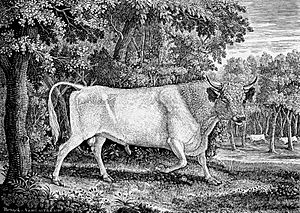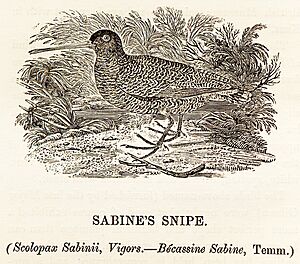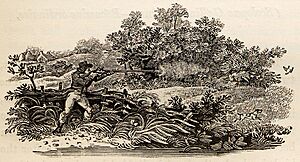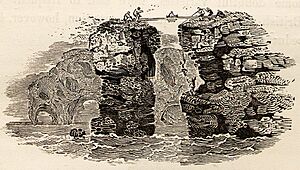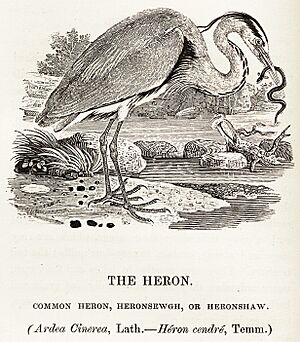A History of British Birds facts for kids
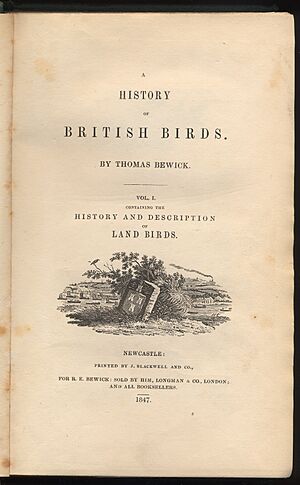
Title-page of 1847 edition
|
|
| Author | Thomas Bewick |
|---|---|
| Illustrator | Thomas Bewick and workshop |
| Country | England |
| Subject | Birds |
| Genre | Natural history |
| Published | 1797–1804 (Bewick, Longman) |
A History of British Birds is a famous natural history book by Thomas Bewick. It was published in two parts. The first part, Land Birds, came out in 1797. The second part, Water Birds, was released in 1804.
People especially love this book for Bewick's amazing wood-engravings. These detailed pictures are considered some of his best work. The book is so well-known that it's even mentioned in Charlotte Brontë's novel Jane Eyre. The poet William Wordsworth also praised Bewick's artistic skill.
This book was one of the first "field guides" for everyday people, not just scientists. Bewick drew each bird accurately, often from real life. He listed the bird's common and scientific names. He also described the bird's looks, where it lived, and how it behaved.
Each bird's entry usually started on a new page. Any empty spaces were filled with small, often funny, woodcuts called "tail-pieces." These showed scenes from country life. British Birds is still printed today and is enjoyed by many readers.
Contents
About Thomas Bewick
Thomas Bewick was born in a small village called Cherryburn in England. When he was 14, he started learning to be an engraver in Newcastle upon Tyne. He learned how to create detailed pictures on wood and metal.
His business grew and became very successful. Bewick and his partner, Ralph Beilby, published a book called History of Quadrupeds in 1790. Because that book did so well, they decided to create a new one about British birds. Bewick spent many years carving the detailed wood blocks for this big project.
Bewick became famous for his engravings. He created pictures for many books, including The Deserted Village by Oliver Goldsmith. One of his most famous prints is The Chillingham Bull. He also illustrated several versions of Aesop's Fables. Bewick had many students who worked with him and learned his skills.
Thomas Bewick passed away on November 8, 1828. He was buried in Ovingham churchyard.
How the Book Was Made
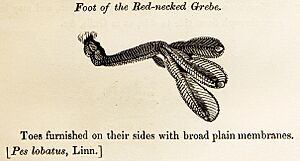
The book A History of British Birds was a big team effort. Thomas Bewick created all the detailed woodcuts (pictures). These pictures were drawn carefully from nature. The descriptions for the Land Birds volume were written by Ralph Beilby. However, Bewick, who knew a lot about birds, checked and corrected the text.
Each bird species is shown over a few pages. First, there's a woodcut picture of the bird. The birds are always shown standing or perched, even water birds. Then, Bewick lists the bird's name, other common names, and its scientific (Latin) and French names. For example, the "Musk Duck" is also called "Cairo, Guinea, or Indian Duck."
The text then describes the bird's size and appearance. It mentions details like eye color, bill, legs, and feathers. Next, it talks about where the bird comes from and where it lives. Bewick often included notes or quotes from other famous naturalists.
He also shared interesting facts about the birds. For the musk duck, he mentioned its "musky smell." If a bird could mix with other species (hybridize), he described that too.
Bewick always thanked the people who helped him. Many birds, especially rare ones, were drawn from preserved skins rather than live birds. For example, the picture of Sabine's snipe was made from a preserved bird given to him by N. A. Vigors. Bewick tried to draw from nature as much as possible.
It was hard for Bewick to group the birds because scientists at the time didn't agree on how to classify them. He used groups like "Of the Falcon," which included different birds of prey. Land birds were grouped by what they ate: birds of prey, omnivores (eat everything), insectivores (eat insects), and granivores (eat grains). Water birds were simply listed, with similar families placed together.
At the end of each bird's description, there's a small woodcut called a tail-piece. These tiny artworks show scenes from country life. They are often funny and always full of Bewick's amazing detail. Some tail-pieces add to the bird's story. For example, for the heron, a tail-piece shows one heron catching an eel. These small pictures often show humans interacting with nature.
What's Inside the Book
Land Birds
The first volume, "containing the History and Description of Land Birds," starts with an introduction. It explains how amazing birds are and how they show the "wisdom, the goodness, and the bounty of Providence."
The introduction talks about birds that eat grain (granivorous) and birds that eat meat (carnivorous). It also discusses how fast birds are, their senses, how they fly, and how they migrate. Bewick mentions how much fun it is to watch birds:
"To the practical ornithologist there arises a considerable gratification in being able to ascertain the distinguishing characters of birds as they appear at a distance, whether at rest, or during their flight."
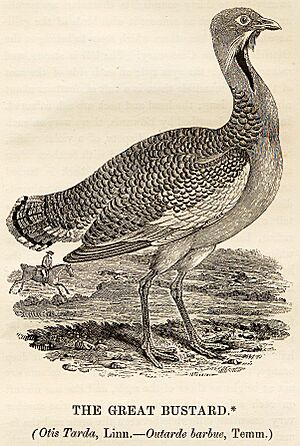
Bewick also thought about protecting nature. He wondered why people let beautiful birds like the Great Bustard become rare. He believed they could be raised like chickens.
The 1847 edition of the book groups the land birds into families:
- Birds of Prey
- Omnivorous Birds
- Insectivorous Birds
- Of the Shrike
- Of the Flycatchers
- Of the Warblers
- Of the Wagtail
- Granivorous Birds
- Of the Lark
- Of the Titmouse
- Of the Bunting
- Of the Finch
- Of the Woodpecker
- Of the Swallow
- Of the Gallinaceous kind (gamebirds)
- Of the Grouse
- Of the Bustard
Water Birds
The second volume, "containing the History and Description of Water Birds," also has its own introduction. Bewick discusses where many seabirds go to lay their eggs and talks more about bird migration. He ends by reflecting on how amazing nature is.
The 1847 edition groups the water birds into families:
- Of the Oyster Catcher
- Of the Plover
- Of the Heron
- Of the Avoset
- Of the Spoonbill
- Of the Ibis
- Of the Curlew
- Of the Sandpiper
- Of the Godwit
- Of the Snipe
- Of the Rail
- Of the Gallinule
- Of the Coot
- Of the Phalarope
- Of the Grebes
- Of the Terns
- Of the Gull
- Of the Predatory Gulls (the skuas)
- Of the Petrel
- Of the Anas (ducks, geese and swans)
- Of the Mergus (sawbill ducks)
- Of the Cormorant
- Of the Gannet
- Of the Divers
- Of the Guillemot
- Of the Auk
- Foreign Birds
The book also includes a small section on "Foreign Birds." These are just listed by species, like the Bearded Vulture or Mino. There are fifteen of these birds, and they appear at the beginning of the volume as an 'Appendix'.
In Culture
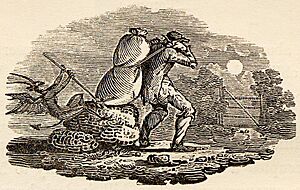
A History of British Birds is mentioned many times in Charlotte Brontë's 1847 novel Jane Eyre.
- When Jane is ten, John Reed throws the book at her.
- Jane uses the book as a way to escape from her unhappy home.
- Jane also uses Bewick's pictures as inspiration for her own artwork.
- Jane and Mr. Rochester, characters in the book, even use bird names for each other, like linnet, dove, and eagle.
Jane Eyre explains and quotes from Bewick's book: "I returned to my book--Bewick's History of British Birds: the letterpress thereof I cared little for, generally speaking; and yet there were certain introductory pages that, child as I was, I could not pass quite as a blank. They were those which treat of the haunts of sea-fowl; of 'the solitary rocks and promontories' by them only inhabited; of the coast of Norway, studded with isles from its southern extremity, the Lindeness, or Naze, to the North Cape--"
The English romantic poet William Wordsworth started his 1800 poem The Two Thieves with these lines:
Oh now that the genius of Bewick were mine
And the skill which he learned on the banks of the Tyne.
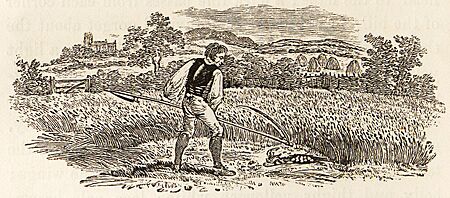
Peter Hall's 1974 film Akenfield includes a scene inspired by one of Bewick's tail-pieces. In the film, a young man is harvesting a cornfield and cries when he accidentally crushes a bird's egg. This comes from Bewick's woodcut for the partridge, which shows a reaper, a dead bird, and its nest of eggs.
Legacy
Bewick was very famous for his wood engravings in the 1800s. The art critic John Ruskin said that the way Bewick drew bird feathers was "the most masterly thing ever done in woodcutting."
Later, new printing methods became popular, and Bewick's work was less in the spotlight. However, his fame for Birds grew across Britain. In 1830, William Yarrell named the Bewick's swan in his honor. Bewick's son, Robert, even engraved this bird for later editions of British Birds.
Thomas Bewick met the American naturalist John James Audubon in 1827. Bewick gave Audubon a copy of his Quadrupeds for his children. Audubon returned the kindness by naming a newly found American bird, Bewick's wren, after his friend.
Bewick's way of organizing text and pictures in his Birds book was very new. It set the stage for how modern field guides are put together today. In fact, a French naturalist named François Holandre created a field guide using Bewick's woodcuts as early as 1800.
Tail-pieces
Here are some of the interesting tail-pieces from the book. They usually don't have captions in the original book.
-
Pegleg and peacock
Principal editions
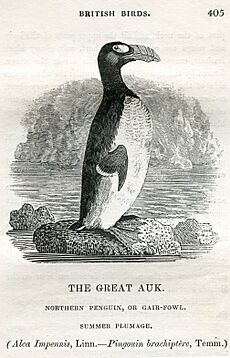
The first part of the book, Volume 1, came out in 1797. It was reprinted several times that year and again in 1798 and 1800. Volume 2 was first published in 1804. The book was reprinted many times, including in 1805, 1809, 1816, and 1817.
In 1821, a new edition was released with extra sections and more pictures. Many more versions followed, including an 8th edition in 1847 and a special 'Memorial Edition' in 1885.
- A History of British Birds. First Edition.
- --- Bewick, Thomas; Beilby, Ralph (1797). Volume 1, Land Birds.
- --- Bewick, Thomas (1804). Volume 2, Water Birds.
Selected modern versions


